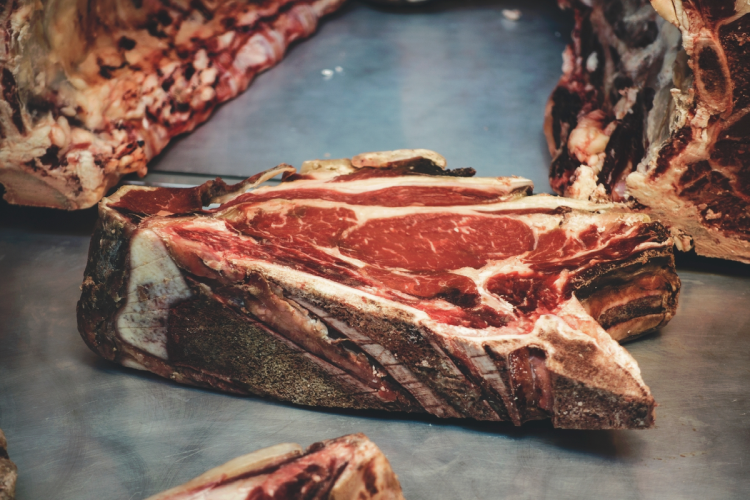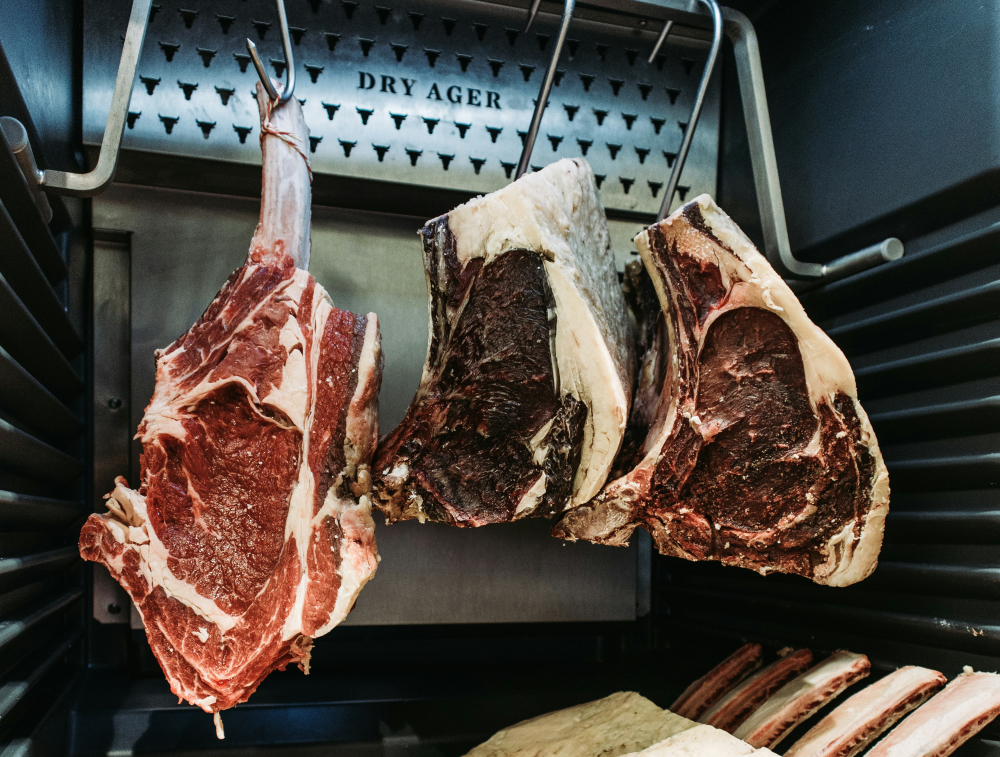Ever wondered how to dry age at home and turn a simple piece of beef into a melt-in-your-mouth masterpiece that seems to sing harmonies of flavors on your palate? Welcome to the world of dry aging, the culinary equivalent of turning lead into gold, except here, it’s all about turning good beef into unforgettable steak. This isn’t just cooking; it’s alchemy. And don’t worry, no philosopher’s stones required, just a bit of patience, science, and a love for great steak.
Whether you’re a seasoned grill master dreaming of that perfect steakhouse-quality cut, or a home cook looking to elevate your dinner game, dry aging beef at home is your next culinary adventure. So, tie on your apron, and let’s embark on a journey through the art and science of how to dry age beef at home. Who knows? By the end of this, you might just be planning your steak-themed dinner party to showcase your new skills.
Disclaimer: Please note that some of the product links in this post may be affiliate links. This means that if you click on these links and make a purchase, we may receive a small commission at no extra cost to you. We include these links to help you find products that we mention and support our site, but decisions to purchase should be made based on personal research and preference. Thank you for supporting our blog!
The Science Behind Dry Aging

Let’s start with a little beefy science. Dry aging at home is like the beef’s rite of passage from being just good to achieving greatness. It’s all about control—controlling humidity, temperature, and airflow to create an environment where magic happens over time. But what’s really going on inside that hunk of meat?
Meat Chemistry 101
At the heart of home dry aging lies a fascinating interplay of meat chemistry. It’s not just about leaving beef in a cool place and hoping for the best; it’s a meticulously controlled decomposition process that turns good beef into an exceptional culinary delight. This transformation is driven by enzymes already present within the meat. These enzymes act like skilled butchers, tenderizing the meat from the inside out and unlocking flavors you didn’t even know beef could possess.
These natural enzymes, mainly cathepsins and proteases, start breaking down the complex proteins in muscle fibers into simpler amino acids. This not only makes the beef more tender but also more flavorful. The breakdown of fats into fatty acids and glycerides further contributes to the development of nutty and cheesy flavors, characteristic of well-aged beef.
Enzymatic Breakdown
Enzymatic breakdown is the unsung hero of dry aging at home, working tirelessly behind the scenes. As these enzymes do their work, they transform the texture and flavor of the beef over weeks. The breakdown of muscle tissue results in a tenderness that can’t be achieved through any cooking method. This process is akin to slow-cooking the beef at a molecular level, allowing the natural flavors to intensify and meld together in a complex, savory harmony.
The enzymatic activity also affects the beef’s fat, breaking it down into aromatic compounds that contribute to the meat’s overall flavor profile. This means that the fat in home dry-aged beef isn’t just a source of juiciness but a flavor powerhouse in its own right. The combination of tenderized muscle and flavorful fat makes each bite of home dry-aged beef a multi-sensory experience.
Moisture Evaporation
Moisture loss plays a critical role in the home dry aging process. From day one, water begins to evaporate from the muscle, slowly reducing the beef’s weight but concentrating its flavor. This concentration effect is what makes home dry-aged beef so rich and intense compared to its fresh counterpart. It’s a bit like reducing a sauce to intensify its flavor; as the water content decreases, what’s left behind is a beefier, more robust taste.
This evaporation isn’t uniform, though. The surface of the meat dries out, forming a hard crust that protects the inner meat from spoiling. This crust is later trimmed away, revealing the tender, flavor-concentrated meat beneath. The balance between enough moisture loss for flavor concentration and preventing the meat from drying out completely is a delicate dance, mastered through precise environmental control.
Effects of Dry Aging
As we peel back the layers of dry aging’s scientific cloak, we’re led into a world where the ordinary is transformed into the extraordinary. The effects of dry aging beef at home are not just a change; they’re a metamorphosis, turning every cut into a testament to flavor and tenderness. This isn’t merely beef aging gracefully; it’s beef elevated to its highest potential, boasting complex flavors and textures that are the stuff of culinary legend. From the deep, concentrated taste that dances across your palate to the tender, almost butter-like consistency that makes each bite a luxurious experience, the effects of home dry aging are a culinary symphony composed over time. Let’s dive into the savory details of how dry aging at home reshapes what beef can be, turning the dining table into a stage for gastronomic excellence.
Flavor Amplification
The most celebrated effect of dry aging at home is the unparalleled flavor it imparts to the beef. This flavor isn’t just “stronger”; it’s more complex, nuanced, and layered. Home dry-aged beef boasts a depth of flavor that reflects the intricate dance of enzymes and the slow concentration of beef’s natural tastes. The savory umami is intensified, complemented by subtle hints of nuttiness and a richness that can only be described as decadent.
Beyond just enhancing the beef’s inherent flavors, dry aging at home introduces entirely new flavor profiles. The breakdown of muscle fibers and fat not only tenderizes the meat and enriches its taste but also creates new flavor compounds. These compounds can evoke comparisons to blue cheese, nuts, and even certain types of cured meats, offering a dining experience that is both familiar and entirely new.
Texture Transformation
The texture of home dry-aged beef is another aspect where the effects of time and science are vividly displayed. The tenderness achieved through dry aging at home is unparalleled, with the meat becoming so soft that it often requires minimal effort to cut. This textural change is not merely a softening of the meat but a transformation into something almost butter-like in its consistency.
This tenderization process enhances the beef’s mouthfeel, making every bite melt in your mouth. The connective tissues and muscle fibers that once made the meat tough are broken down into gelatin through slow, natural enzymatic activity, contributing to a luxurious eating experience. This makes home dry-aged beef not just a meal, but a delicacy to be savored, with each bite offering a testament to the wonders of patience and time.
Weight Loss and Cost
The process of dry aging beef at home inevitably leads to weight loss in the beef, primarily through moisture evaporation and the trimming of the dried-out exterior. This reduction in volume is a significant factor in the higher cost of home dry-aged beef, as what remains is denser, richer, and more flavorful, but also less in quantity. The cost, however, reflects not just the loss of weight but the gain in culinary value—each slice of home dry-aged beef is packed with intensified flavors and tender textures that are the hallmark of high-quality gastronomy.
Despite the higher price tag, the unique taste and texture of home dry-aged beef make it a sought-after luxury for many culinary enthusiasts. The investment in time and resources required to produce dry-aged beef at home is a testament to the artistry and science of gastronomy, offering an unmatched eating experience that justifies the expense.
Techniques of Dry Aging

Now that we’ve explored the why, let’s talk about the how to dry age beef at home. Dry aging beef might sound like something only professional chefs or butchers can do, but with a little know-how and patience, you can recreate this process at home. Whether you have aspirations of commercial scale aging or just want to experiment in your kitchen, here’s how to get started with dry aging at home.
Commercial Scale
On a commercial scale, dry aging is done in specialized rooms where humidity, temperature, and airflow are meticulously controlled. These rooms are filled with racks of aging beef, creating a sight that’s nothing short of a carnivore’s dream. The key here is consistency and environment control, ensuring that each cut ages perfectly. For those thinking of converting their basements into aging chambers, remember, it’s all fun and games until you realize your entire house smells like a steakhouse.
Rack in Fridge Method:
For the home chef looking to dabble in dry aging, using a rack in your fridge is a great starting point. Here’s how to avoid turning your fridge into a science experiment gone wrong while dry aging at home:
- Choose the right cut: Larger cuts like ribeye or sirloin work best.
- Set the stage: Place the beef on a wire rack over a tray to catch any drips, ensuring good airflow around the meat.
- Temperature control: Keep your fridge between 34°F to 38°F. Any warmer and you’re in the danger zone; any colder and you’re just freezing your beef, not aging it.
- Patience, young grasshopper: Aging can take anywhere from 30 to 45 days, or even longer if you’re after a more intense flavor. Just remember, checking on it every day won’t make it age faster.
Given these requirements, it’s worth considering the use of a dedicated fridge for your dry aging endeavors at home. A dedicated fridge offers an undisturbed environment where temperature and humidity levels can be consistently maintained, crucial for the slow and steady aging process. This controlled setting also prevents the mingling of aromas between your aging beef and other food items, keeping your kitchen’s ecosystem harmonious and your flavors pure. Moreover, dedicating a space to your culinary experiment ensures ample room for airflow and proper aging, free from the everyday shuffle of groceries that could compromise the process. Embracing a dedicated fridge for dry aging at home not only simplifies management of these critical factors but also elevates your home cooking into a realm of gourmet craftsmanship, yielding results that are truly worth the wait.
Recommended Gear
- Pan and rack to let air circulate around the meat: Half Sheet Pan & Rack Set
- For the fancy amongst us, you can get this fridge designed for day aging: SteakAger PRO 40
Dry Age Bags:
Dry age bags are the modern magic of meat aging. These special bags allow moisture to escape while keeping bacteria out, simulating the dry aging process at home without needing a dedicated fridge or room. Here’s your step-by-step guide to bag aging success at home:
- Bag it up: Place your beef cut in the dry age bag and seal it with a vacuum sealer. Make sure it’s as air-free as possible.
- Fridge time: Place it on a wire rack in your fridge, just like the traditional method.
- Wait it out: Aging in bags can take a bit less time, but you’re still looking at a few weeks for that perfect flavor and texture.
- The reveal: After aging, remove the beef from the bag, trim any hardened outer layers, and prepare for one of the best steaks of your life.
With these techniques, you can bring the esteemed process of dry aging into your own kitchen, turning ordinary beef into extraordinary meals. Whether you’re setting up a commercial operation or just experimenting at home, the key ingredients are the same: patience, precision, and a passion for great steak.
Recommended Gear
- UMAi Dry Aging Bag for Brisket or Bone-In
- UMAi Dry Aging Bag for Ribeye & Striploin
- For those unsure about which size to get: UMAi Dry Aging Bag Sampler Pack
Conclusion
Embarking on the dry-aging journey at home is a testament to your dedication to culinary excellence. Whether you’re aiming to impress dinner guests or simply treating yourself to a gourmet experience at home, dry-aged beef is a luxurious addition to any menu. Remember, good things come to those who wait—especially when it comes to steak. So, go ahead, give dry aging at home a try. Your taste buds will thank you.
With this flavorful journey through the art and science of dry aging, you’re now equipped to elevate your beef from ordinary to extraordinary. Happy aging!

